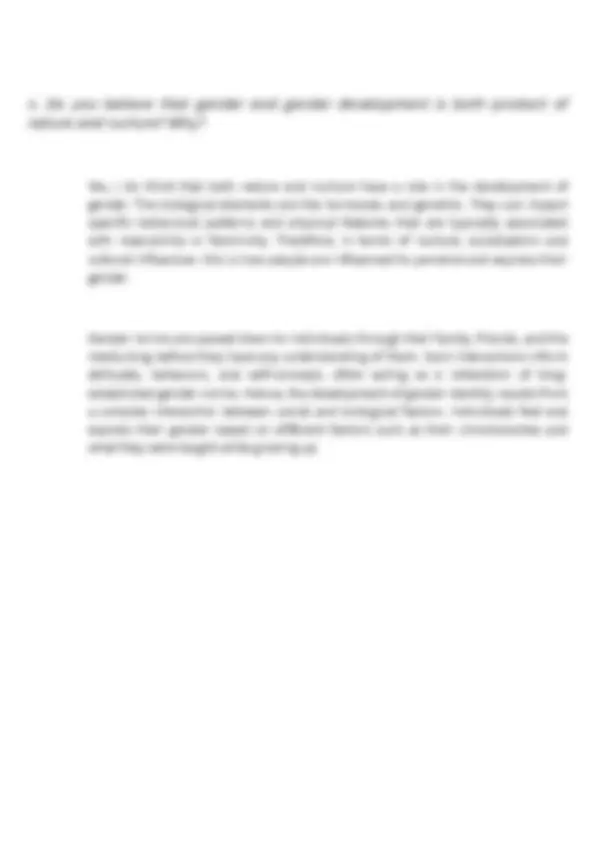




Study with the several resources on Docsity

Earn points by helping other students or get them with a premium plan


Prepare for your exams
Study with the several resources on Docsity

Earn points to download
Earn points by helping other students or get them with a premium plan
Community
Ask the community for help and clear up your study doubts
Discover the best universities in your country according to Docsity users
Free resources
Download our free guides on studying techniques, anxiety management strategies, and thesis advice from Docsity tutors
electrical engineering gender and society third year
Typology: Cheat Sheet
1 / 4

This page cannot be seen from the preview
Don't miss anything!



Activity NO. 1 GEE2: Gender and Society 1st Semester, A.Y. 2024- NAME: GLADY VELLE C. BALANAG SECTION: BSME-3B The question whether an individual becomes man or woman based solely on their primary and secondary sexes is complex and multifaced issue that intersects various domains, including biology, sociology, psychology and philosophy. It is not possible to determine a person's identity as a man or woman only by their primary and secondary sexual traits. Although physical characteristics like body hair and breast development, as well as reproductive organs, are frequently used to determine a child's gender at birth yet they do not fully convey the complexities of gender identity. Gender is a more comprehensive term that encompasses personal, cultural, and social aspects. The traditional belief that biological sex and gender are synonymous is being questioned more and more in many nations. People's perceptions of themselves and how they desire to be identified—their gender identity—may not always coincide with their physical characteristics. And someone born with a feminine given gender may identify as male, and vice versa. Furthermore, some people identify as non-binary or genderqueer, which is a category that defies the binary distinctions between man and woman. In conclusion, while main and secondary sex traits influence a person's biological sex, gender is not determined by them. The contrast between gender identity and biological sex underscores the need of acknowledging personal self- identification and the multiplicity of human experiences that extend beyond physical characteristics.
The biological makeup and societal training of an individual both impact their masculinity and femininity. Hormones such as estrogen and testosterone have the biological capacity to influence behavioral and physical attributes that are conventionally linked to either femininity or masculinity. These expressions are more significantly shaped by societal and cultural conventions, though. Gender roles are instilled in people from an early age by their families, the media, and society norms. What constitutes masculine or feminine behavior, looks, and interests is determined by these outside factors. As a result of people's gradual internalization of these concepts and behavioral adaptations, masculinity and femininity are now more heavily influenced by cultural context than by biology.
It is normal for men and women to have strong urges to become men and women, respectively. People are allowed to express themselves in ways that are compatible with their true sense of self, as gender identification is a very personal matter. Many people discover that their gender identity does not align with the sex assigned at birth, making the transition process an important step toward personal fulfillment and happiness. One's sense of self and lived experience are undermined when these desires are discounted or denounced, which is harmful. People are becoming aware that gender is not always black or white, and that everyone has the right to select their own gender identity. Honoring these wishes promotes a more caring, compassionate, and inclusive culture.